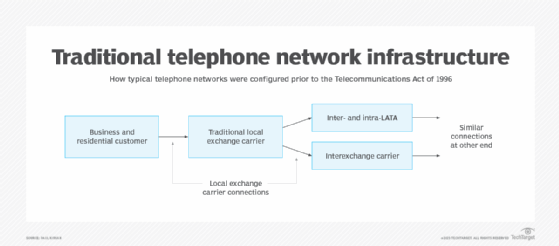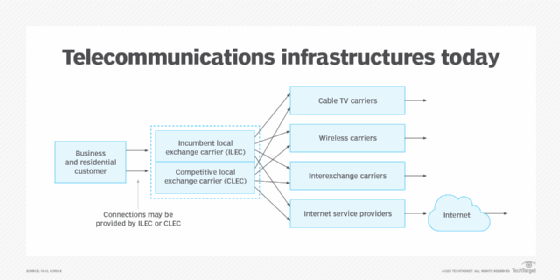incumbent local exchange carrier (ILEC)
What is an incumbent local exchange carrier (ILEC)?
An incumbent local exchange carrier (ILEC) is a type of U.S. telephone company that provided local service when the Telecommunications Act of 1996 was enacted. ILECs include the former Bell Operating Companies, which were grouped into holding companies known collectively as the Regional Bell Operating Companies, or Baby Bells, when AT&T's Bell System was broken up by a 1982 consent decree.
ILECs operate side by side with competitive local exchange carriers (CLECs) to provide local telephony access, as well as advanced and value-added services to subscribers.
A local exchange is the name for the local central office of a local exchange carrier (LEC). Lines from homes and business phones terminate at a local exchange central office. Local exchanges connect to other local exchanges within a local access and transport area (LATA) or to interexchange carriers (IXCs), such as long-distance carriers AT&T and Verizon.
How does an ILEC work?
Where landlines are still in use, ILECs provide a major part of the telecommunications infrastructure. They traditionally have provided the physical networks that connect people and businesses. Those original networks used mostly copper cable. Over time, coaxial cable, fiber optic cable and wireless services have been added. The internet also has links to ILECs, CLECs and many other communication service providers.
In a typical central office, large cable-connecting racks distributed the physical cables to businesses and residences. From the LEC phone company to the customer premises, these cables are deployed overhead on poles or buried underground in conduits and trenches.
Today, a typical telephone pole shares several network infrastructures: traditional wireline telephony, fiber optic networks, cable TV networks and electric power. Switching systems in central offices establish a variety of connections between telecom service subscribers and other service providers, especially via the internet.
Before the Telecommunications Act of 1996, the local central office linked residential and business customers to one of the following three calling options:
- Local telephone calls within the local calling area.
- Regional calls within the same state via state-based central offices using intra- and inter-LATA connections.
- Out-of-state calls via IXCs.
Calls were and still are completed to the target subscriber via similar carriers -- wireline or wireless today -- at the other end of the call.

How the Telecommunications Act of 1996 changed things
In the years after the Telecommunications Act of 1996, the Federal Communications Commission (FCC) expanded the LEC model. The act created CLECs, a new class of carrier, opening up competition to the traditional telephony companies. These companies were permitted to physically colocate within traditional central office buildings and deliver their services over ILEC-provided channels. This configuration is still in use and gives customers more choices in communications and network services.
In voice and data communications, ILECs and CLECs coexist at different levels. CLECs often install their equipment in the same building as ILECs and provide local access phone lines to customers; these services are mostly for business customers needing leased lines.
The growth of the internet has raised the capabilities of the existing telecom infrastructure to higher levels. Improvements in computer systems, networking protocols and standards helped launch new services.
Today, just about everything telecom can be found in a traditional ILEC central office building. Major U.S. cities often have former telephone company central offices retrofitted as carrier hotels that house ILECs, different types of CLECs, specialized service providers and common carriers.

Who uses ILECs?
Residential and business telephone service customers who use physical landline connections are most likely using ILEC resources to get voice, data, video and internet services. For those who access resources using wireless connections, those links at some point connect through an ILEC office.
Wireless carriers connect to ILECs and CLECs for connectivity over nonwireless networks. Cable TV operators and wireless carriers can provide local access, but somewhere along the connection, they use ILECs and CLECs.
The future of ILECs
ILECs and CLECs aren't likely to disappear any time soon. They're the glue that holds together the national networking infrastructure. They have acquired other types of companies to bolster their service offerings and merged with one another to create even larger entities. The FCC and other government agencies monitor these mergers and acquisitions to ensure that no one organization gets too large.
The challenge for ILECs today is to offer good basic service, along with more advanced features and functionality, such as voice over IP, advanced routing and solid service reliability. The variety and diversity of telecom companies and their offerings mean that customers must do their homework to secure the best telecommunication services and best deals.
Learn about the various telecommunications certifications to bolster your career.



